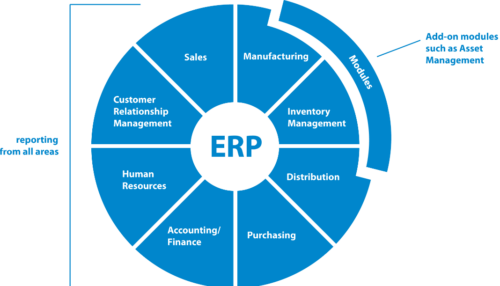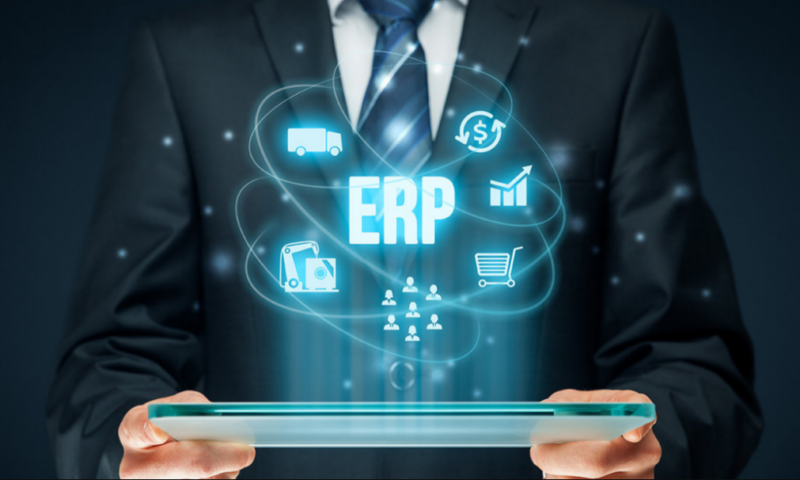Boost productivity with our SAAS ERP solution. Streamline operations and enhance efficiency with our cloud-based Enterprise Resource Planning software. In today’s fast-paced business landscape, staying competitive requires efficient and streamlined operations. Traditional business processes and on-premises systems often fall short in meeting the demands of modern businesses.
This is where SAAS (Software as a Service) ERP (Enterprise Resource Planning) solutions step in as the future of streamlining business operations. In the digital age, businesses are constantly seeking ways to enhance efficiency, reduce costs, and improve decision-making processes. ERP systems have played a pivotal role in achieving these objectives for decades. However, the emergence of SAAS ERP solutions has transformed the way organizations manage their operations.
Understanding ERP
ERP, or Enterprise Resource Planning, refers to a suite of integrated applications that help organizations manage core business processes. These processes include finance, human resources, supply chain management, procurement, and more. ERP systems provide a centralized repository of data, streamlining workflows and facilitating data-driven decision-making.
The Evolution of ERP Systems
Traditional ERP systems were typically hosted on-premises, requiring significant upfront investments in hardware, software, and IT personnel. While they were effective, they often posed challenges in terms of scalability and accessibility. Enterprise Resource Planning (ERP) systems have come a long way since their inception. To understand the significance of SAAS ERP solutions in the present day, it’s essential to trace the evolution of ERP systems over the years.
Early ERP Systems
The concept of ERP systems first emerged in the 1960s and 1970s when businesses began to realize the need for integrated software solutions. Early ERP systems primarily focused on automating back-office functions like accounting and inventory management. These systems were on-premises solutions that required substantial investments in hardware and software.
Expansion of Functionality
As businesses recognized the potential benefits of ERP systems, software developers started expanding their functionality. ERP systems began to encompass a broader range of business processes, including human resources, supply chain management, and customer relationship management. This expansion allowed organizations to streamline multiple facets of their operations within a single platform.
The Y2K Challenge
The late 1990s marked a significant milestone in the ERP world as the Y2K bug loomed large. Many organizations upgraded their ERP systems to ensure they could handle the transition from 1999 to 2000 seamlessly. This event pushed ERP providers to enhance the reliability and scalability of their solutions.
Transition to Client-Server Architecture
In the early 2000s, ERP systems underwent a crucial architectural shift from mainframe-based systems to client-server architecture. This change improved system performance, made it easier to deploy updates, and allowed for greater user accessibility.
The Emergence of Cloud-Based ERP
The 2010s saw the emergence of cloud-based ERP solutions, including SAAS ERP. This shift revolutionized the ERP landscape. Cloud ERP eliminated the need for on-premises hardware, reduced upfront costs, and offered scalability and accessibility like never before.
Businesses could now access their ERP systems from anywhere with an internet connection, making remote work and collaboration more efficient. Integration with Emerging Technologies Today’s ERP systems are not just about managing business processes; they are also integrated with emerging technologies like artificial intelligence (AI), machine learning (ML), and the Internet of Things (IoT).
These integrations provide organizations with advanced analytics, automation, and predictive capabilities, enhancing decision-making and efficiency. Customization and Industry-Specific Solutions Modern ERP solutions are highly customizable, allowing businesses to tailor them to their specific industry needs. Whether you’re in manufacturing, healthcare, or finance, there are ERP solutions designed to address the unique challenges of your sector.
The Rise of SAAS ERP Solutions SAAS ERP solutions have emerged as a game-changer in the ERP landscape. These cloud-based systems offer several advantages that are shaping the future of business operations.
Key Benefits of SAAS ERP Solutions
Enhanced Accessibility and Mobility One of the primary advantages of SAAS ERP is its accessibility. Authorized users can access the system from anywhere with an internet connection. This promotes remote work and enhances collaboration, especially in today’s remote-friendly work environments. One of the standout features of SAAS (Software as a Service) ERP (Enterprise Resource Planning) solutions is their remarkable accessibility and mobility.
In today’s dynamic business environment, the ability to access critical business data and processes from anywhere, at any time, has become a game-changer. Here’s how enhanced accessibility and mobility are shaping the future of business operations:
Access Anytime, Anywhere SAAS ERP systems are hosted in the cloud, which means that authorized users can access the system from virtually anywhere with an internet connection.
This level of accessibility breaks down the traditional boundaries of office-based work. Employees can access the ERP system from their home, while on a business trip, or even from a different country. This flexibility is particularly valuable in an era where remote work and global collaborations are becoming the norm.
Empowering Remote Work The rise of remote work has been accelerated by technological advancements, and SAAS ERP solutions are at the forefront of this transformation. With employees no longer tethered to their desks, companies can tap into a global talent pool and offer their teams a better work-life balance. SAAS ERP solutions ensure that employees have the necessary tools and data to carry out their tasks efficiently, regardless of their physical location.
Collaboration Made Easy In addition to individual mobility, SAAS ERP fosters collaboration within organizations. Team members can collaborate on projects and access shared data seamlessly. This real-time collaboration promotes efficient teamwork, even when team members are dispersed across different time zones. Communication and data sharing are no longer hindered by physical proximity.
Quick Decision-Making Business decisions often require timely access to critical data. SAAS ERP’s mobile accessibility ensures that decision-makers can access real-time data and analytics on the go. Whether it’s reviewing financial reports during a meeting or checking inventory levels while visiting a supplier, mobile access to ERP data empowers decision-makers to make informed choices promptly.
Enhanced Customer Engagement Mobility also extends to customer engagement. Sales representatives can access customer information and order histories while meeting clients, providing personalized service and quick responses to inquiries. This mobility enhances the overall customer experience and helps in building long-lasting relationships.
Security and Data Protection While mobility is essential, it must not compromise data security. SAAS ERP providers prioritize data security and implement robust measures to protect sensitive information. Data is encrypted, access is controlled, and regular security updates are performed, ensuring that data remains safe even in a mobile environment.
– Cost-Efficiency and Scalability SAAS ERP eliminates the need for substantial upfront investments in infrastructure. Instead, businesses pay a subscription fee, making it a cost-effective option. Additionally, scalability is seamless, allowing organizations to adapt to changing needs effortlessly.
– Real-Time Data and Analytics SAAS ERP systems provide real-time data updates and robust analytics tools. This empowers businesses to make data-driven decisions promptly, leading to improved overall performance.
– Seamless Integration Integration with other software applications is a breeze with SAAS ERP. Whether it’s connecting with CRM systems or e-commerce platforms, SAAS ERP fosters a seamless flow of data across the organization.
– Security and Compliance Cloud-based SAAS ERP providers prioritize data security and compliance. They invest heavily in cybersecurity measures and adhere to industry standards, ensuring your data remains safe and compliant.
– User-Friendly Interface SAAS ERP systems are known for their user-friendly interfaces. They are designed with the end-user in mind, making training and adoption smoother for employees.
– Challenges and Considerations While SAAS ERP solutions offer numerous benefits, organizations must consider factors such as data privacy, vendor reliability, and the need for a stable internet connection when transitioning to the cloud.
– Choosing the Right SAAS ERP Solution Selecting the most suitable SAAS ERP solution requires careful evaluation of your organization’s needs, budget, and long-term goals. It’s essential to partner with a reputable SAAS ERP provider that aligns with your business objectives.
– Implementing SAAS ERP The successful implementation of SAAS ERP involves thorough planning, training, and change management strategies. Engaging employees and ensuring a smooth transition are crucial for maximizing the benefits.
FAQs
Are SAAS ERP solutions suitable for small businesses? Yes, SAAS ERP solutions are scalable and can be adapted to the needs of small businesses, making them a viable option.
What is the difference between on-premises ERP and SAAS ERP? On-premises ERP requires hosting the software on your own servers, while SAAS ERP is cloud-based and hosted by a third-party provider.
How can SAAS ERP improve decision-making? SAAS ERP provides real-time data and analytics, enabling faster and more informed decision-making.
Is data security a concern with SAAS ERP? Reputable SAAS ERP providers prioritize data security and compliance, making them a secure choice for businesses.
Can SAAS ERP solutions be customized to specific industry needs? Yes, many SAAS ERP solutions offer customization options to meet the unique requirements of different industries.
SAAS ERP solutions are revolutionizing the way businesses operate, providing the agility and efficiency needed to thrive in today’s dynamic market. Embracing this technological shift is not just a choice but a necessity for those aiming to stay ahead of the competition.
Conclusion
In conclusion, SAAS ERP solutions represent the future of streamlined business operations. Their accessibility, cost-efficiency, real-time capabilities, and user-friendly interfaces make them indispensable tools for businesses seeking to thrive in today’s competitive landscape.


